Supply Chain Analysis and Design: Case Study on Logistics
VerifiedAdded on 2023/06/08
|8
|1284
|223
Case Study
AI Summary
This case study analyzes a logistics and supply chain scenario, employing a linear programming model to determine the optimal production levels for a four-month period to minimize total production costs. It calculates the required number of workers, closing inventory, and optimal production schedules. The analysis includes detailed breakdowns of costs, such as raw materials, labor (standard and overtime), hiring and firing costs, and holding costs. The optimal production schedule is presented with monthly production figures, opening and closing stock, and demand. The analysis also examines the impact of the number of employees on total business costs, highlighting the relationship between labor and profitability, and the use of a graph to visualize the cost variations with the number of workers. The total production cost is computed, and various cost components are detailed, offering a comprehensive understanding of the financial aspects involved in supply chain management.
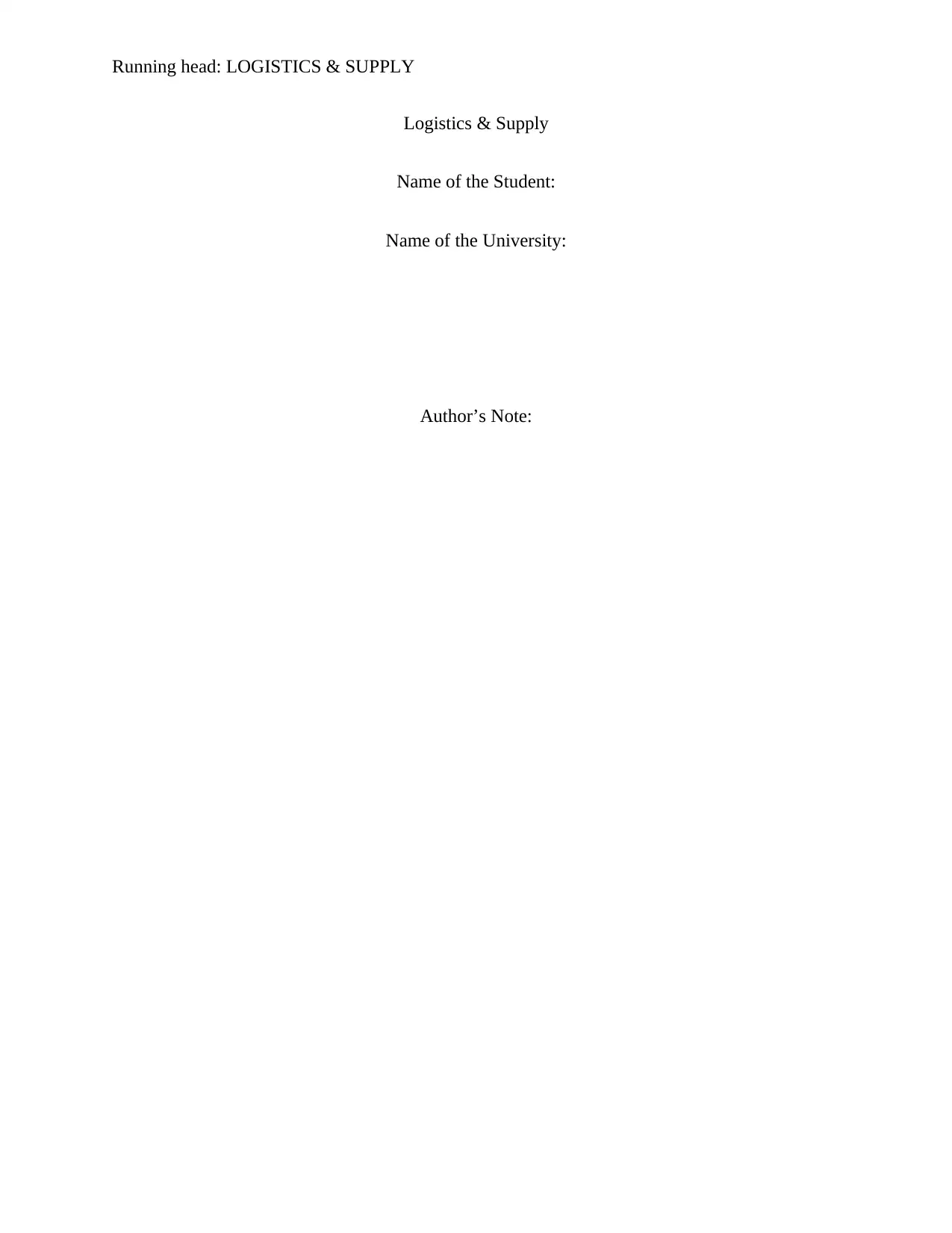
Running head: LOGISTICS & SUPPLY
Logistics & Supply
Name of the Student:
Name of the University:
Author’s Note:
Logistics & Supply
Name of the Student:
Name of the University:
Author’s Note:
Paraphrase This Document
Need a fresh take? Get an instant paraphrase of this document with our AI Paraphraser
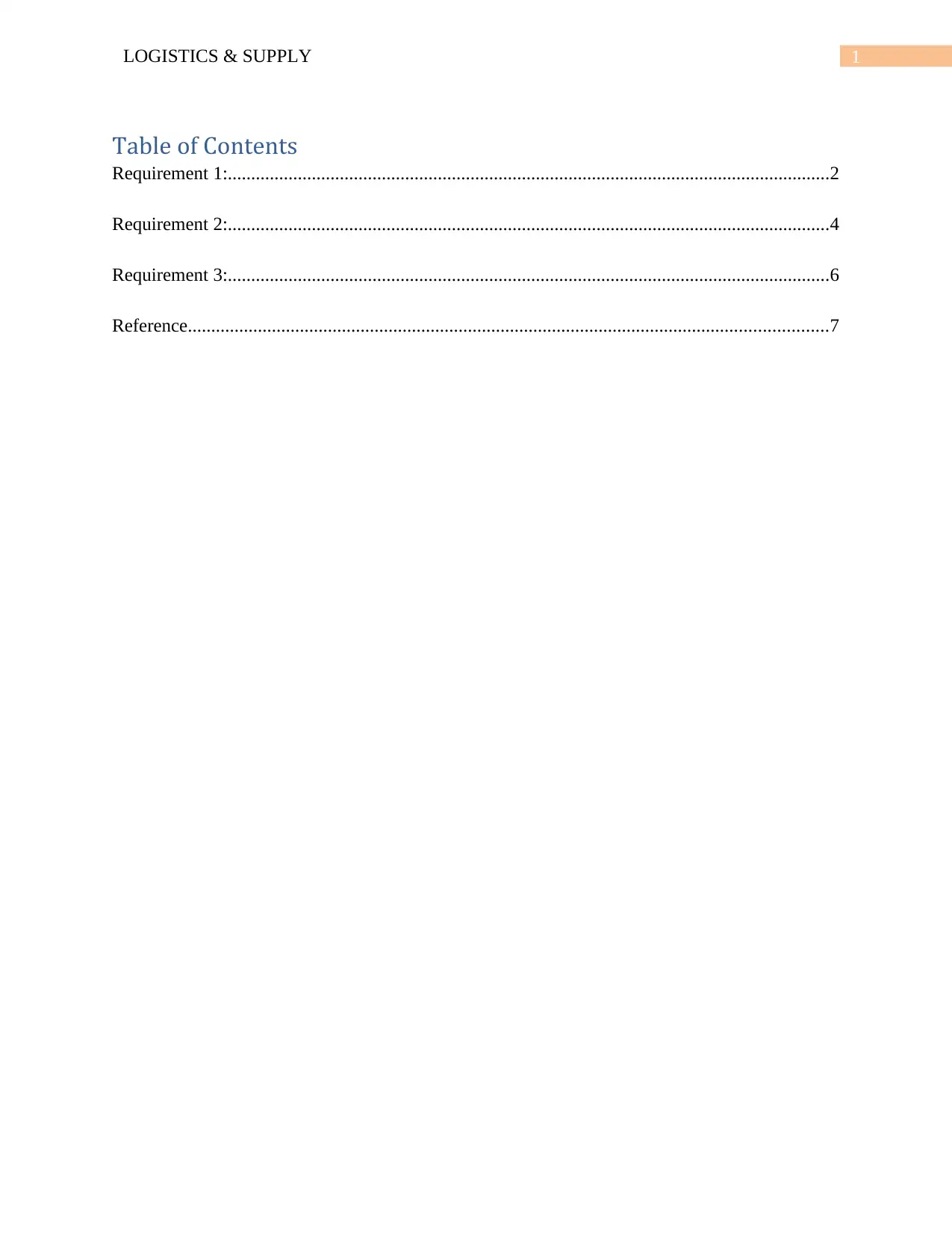
1LOGISTICS & SUPPLY
Table of Contents
Requirement 1:.................................................................................................................................2
Requirement 2:.................................................................................................................................4
Requirement 3:.................................................................................................................................6
Reference.........................................................................................................................................7
Table of Contents
Requirement 1:.................................................................................................................................2
Requirement 2:.................................................................................................................................4
Requirement 3:.................................................................................................................................6
Reference.........................................................................................................................................7
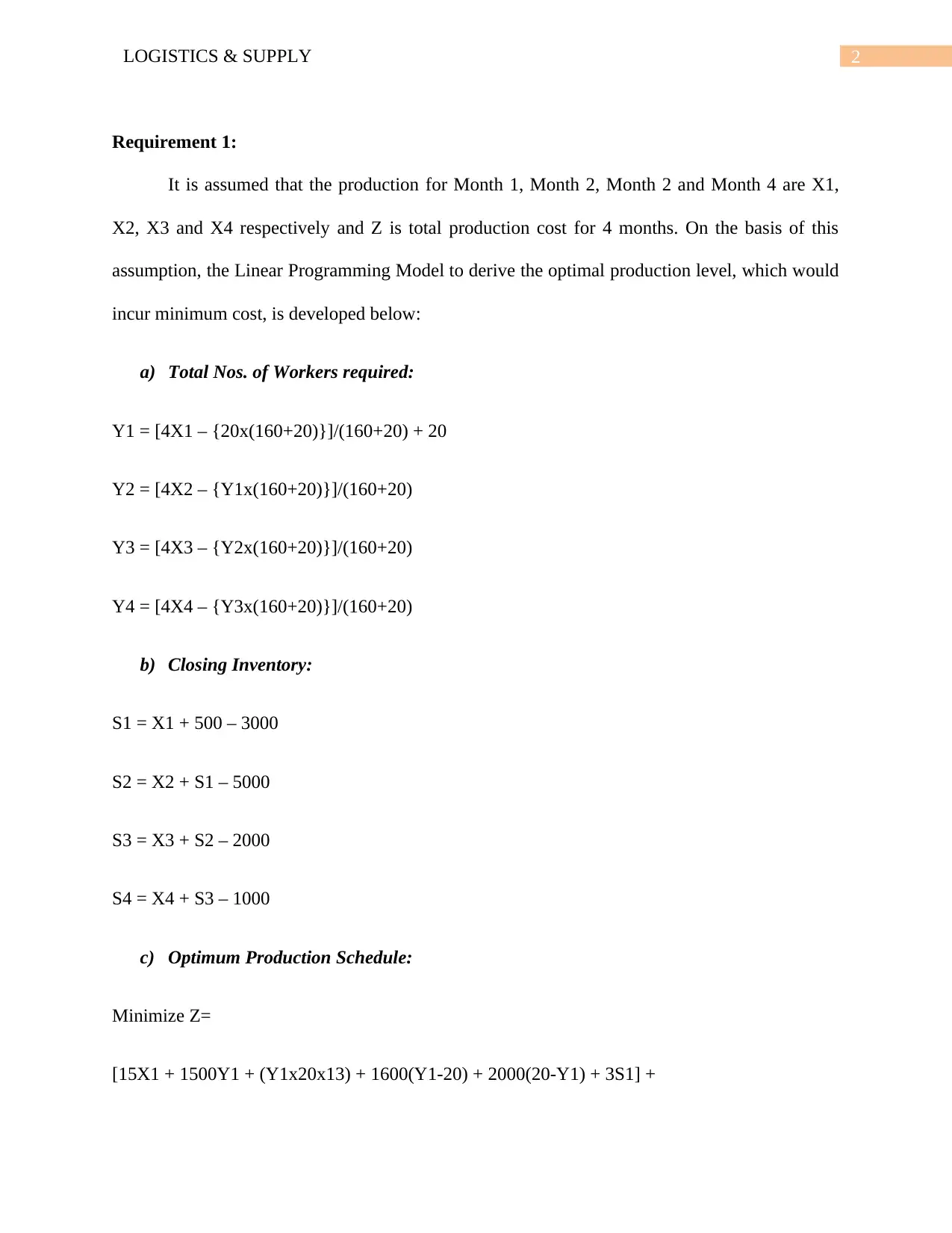
2LOGISTICS & SUPPLY
Requirement 1:
It is assumed that the production for Month 1, Month 2, Month 2 and Month 4 are X1,
X2, X3 and X4 respectively and Z is total production cost for 4 months. On the basis of this
assumption, the Linear Programming Model to derive the optimal production level, which would
incur minimum cost, is developed below:
a) Total Nos. of Workers required:
Y1 = [4X1 – {20x(160+20)}]/(160+20) + 20
Y2 = [4X2 – {Y1x(160+20)}]/(160+20)
Y3 = [4X3 – {Y2x(160+20)}]/(160+20)
Y4 = [4X4 – {Y3x(160+20)}]/(160+20)
b) Closing Inventory:
S1 = X1 + 500 – 3000
S2 = X2 + S1 – 5000
S3 = X3 + S2 – 2000
S4 = X4 + S3 – 1000
c) Optimum Production Schedule:
Minimize Z=
[15X1 + 1500Y1 + (Y1x20x13) + 1600(Y1-20) + 2000(20-Y1) + 3S1] +
Requirement 1:
It is assumed that the production for Month 1, Month 2, Month 2 and Month 4 are X1,
X2, X3 and X4 respectively and Z is total production cost for 4 months. On the basis of this
assumption, the Linear Programming Model to derive the optimal production level, which would
incur minimum cost, is developed below:
a) Total Nos. of Workers required:
Y1 = [4X1 – {20x(160+20)}]/(160+20) + 20
Y2 = [4X2 – {Y1x(160+20)}]/(160+20)
Y3 = [4X3 – {Y2x(160+20)}]/(160+20)
Y4 = [4X4 – {Y3x(160+20)}]/(160+20)
b) Closing Inventory:
S1 = X1 + 500 – 3000
S2 = X2 + S1 – 5000
S3 = X3 + S2 – 2000
S4 = X4 + S3 – 1000
c) Optimum Production Schedule:
Minimize Z=
[15X1 + 1500Y1 + (Y1x20x13) + 1600(Y1-20) + 2000(20-Y1) + 3S1] +
⊘ This is a preview!⊘
Do you want full access?
Subscribe today to unlock all pages.

Trusted by 1+ million students worldwide
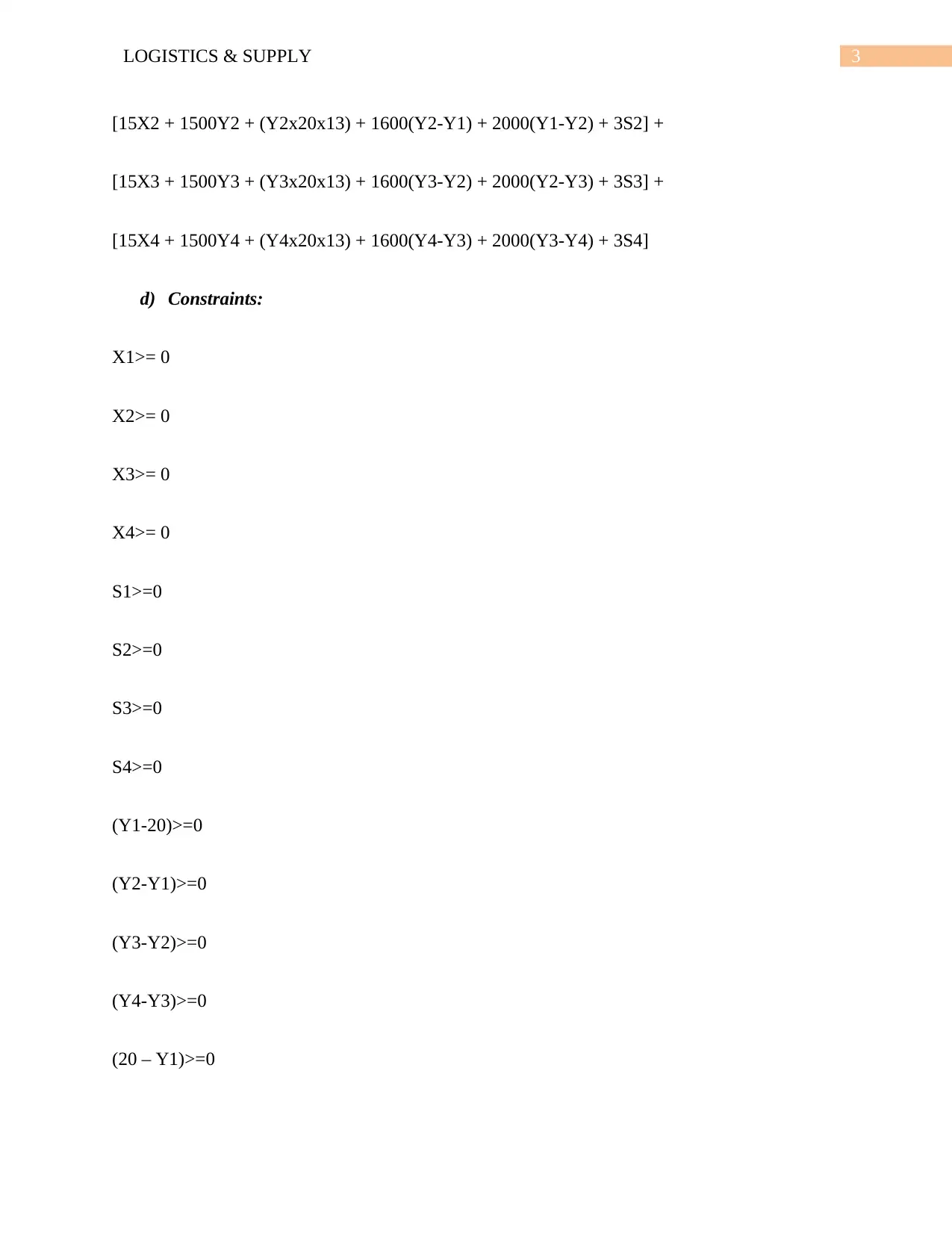
3LOGISTICS & SUPPLY
[15X2 + 1500Y2 + (Y2x20x13) + 1600(Y2-Y1) + 2000(Y1-Y2) + 3S2] +
[15X3 + 1500Y3 + (Y3x20x13) + 1600(Y3-Y2) + 2000(Y2-Y3) + 3S3] +
[15X4 + 1500Y4 + (Y4x20x13) + 1600(Y4-Y3) + 2000(Y3-Y4) + 3S4]
d) Constraints:
X1>= 0
X2>= 0
X3>= 0
X4>= 0
S1>=0
S2>=0
S3>=0
S4>=0
(Y1-20)>=0
(Y2-Y1)>=0
(Y3-Y2)>=0
(Y4-Y3)>=0
(20 – Y1)>=0
[15X2 + 1500Y2 + (Y2x20x13) + 1600(Y2-Y1) + 2000(Y1-Y2) + 3S2] +
[15X3 + 1500Y3 + (Y3x20x13) + 1600(Y3-Y2) + 2000(Y2-Y3) + 3S3] +
[15X4 + 1500Y4 + (Y4x20x13) + 1600(Y4-Y3) + 2000(Y3-Y4) + 3S4]
d) Constraints:
X1>= 0
X2>= 0
X3>= 0
X4>= 0
S1>=0
S2>=0
S3>=0
S4>=0
(Y1-20)>=0
(Y2-Y1)>=0
(Y3-Y2)>=0
(Y4-Y3)>=0
(20 – Y1)>=0
Paraphrase This Document
Need a fresh take? Get an instant paraphrase of this document with our AI Paraphraser
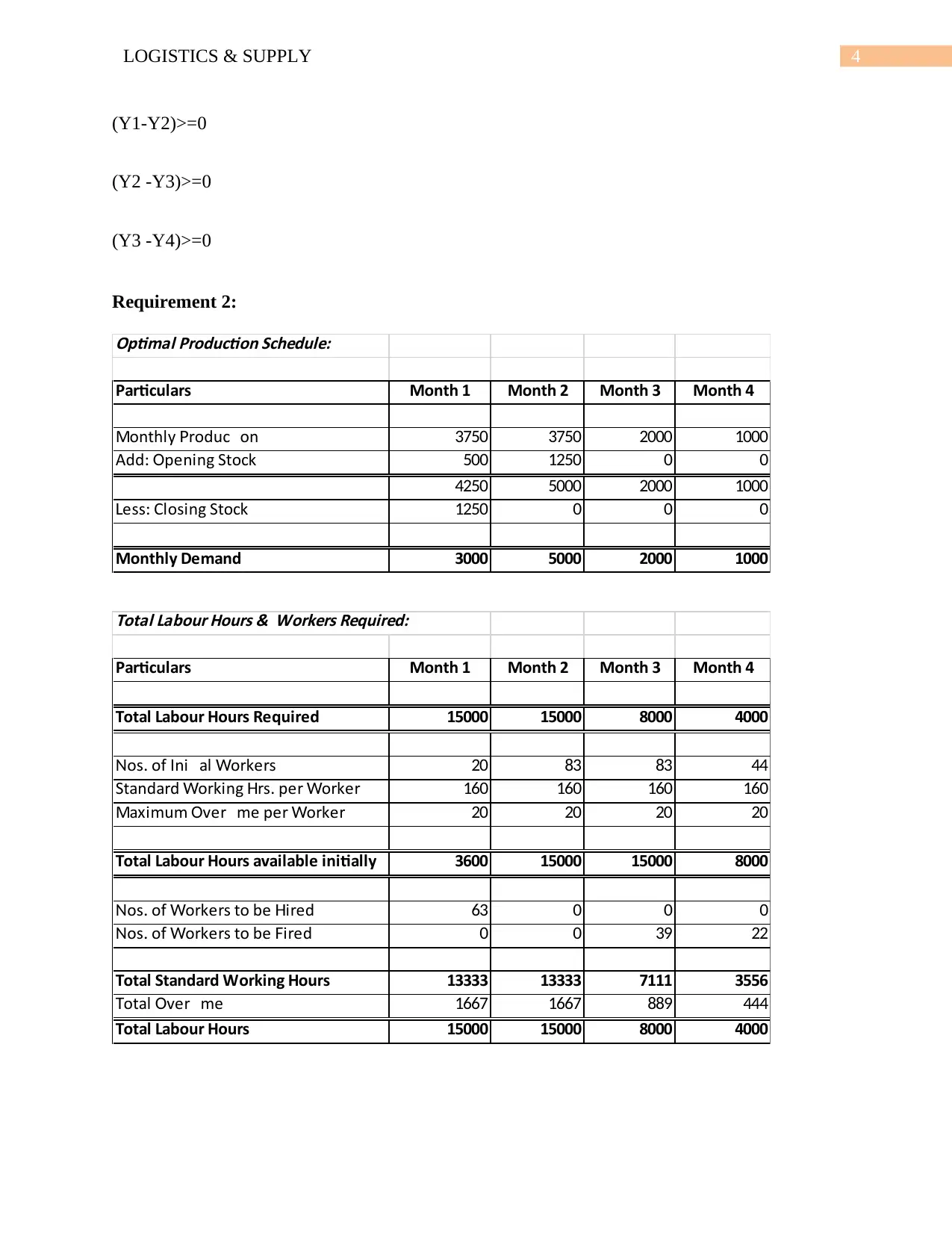
4LOGISTICS & SUPPLY
(Y1-Y2)>=0
(Y2 -Y3)>=0
(Y3 -Y4)>=0
Requirement 2:
Optimal Production Schedule:
Particulars Month 1 Month 2 Month 3 Month 4
Monthly roducti onP 3750 3750 2000 1000
Add pening Stock: O 500 1250 0 0
4250 5000 2000 1000
ess Closing StockL : 1250 0 0 0
Monthly Demand 3000 5000 2000 1000
Total Labour Hours & Workers Required:
Particulars Month 1 Month 2 Month 3 Month 4
Total Labour Hours Required 15000 15000 8000 4000
os of niti al orkersN . I W 20 83 83 44
Standard orking rs per orkerW H . W 160 160 160 160
Ma imum verti me per orkerx O W 20 20 20 20
Total Labour Hours available initially 3600 15000 15000 8000
os of orkers to be iredN . W H 63 0 0 0
os of orkers to be iredN . W F 0 0 39 22
Total Standard Working Hours 13333 13333 7111 3556
otal verti meT O 1667 1667 889 444
Total Labour Hours 15000 15000 8000 4000
(Y1-Y2)>=0
(Y2 -Y3)>=0
(Y3 -Y4)>=0
Requirement 2:
Optimal Production Schedule:
Particulars Month 1 Month 2 Month 3 Month 4
Monthly roducti onP 3750 3750 2000 1000
Add pening Stock: O 500 1250 0 0
4250 5000 2000 1000
ess Closing StockL : 1250 0 0 0
Monthly Demand 3000 5000 2000 1000
Total Labour Hours & Workers Required:
Particulars Month 1 Month 2 Month 3 Month 4
Total Labour Hours Required 15000 15000 8000 4000
os of niti al orkersN . I W 20 83 83 44
Standard orking rs per orkerW H . W 160 160 160 160
Ma imum verti me per orkerx O W 20 20 20 20
Total Labour Hours available initially 3600 15000 15000 8000
os of orkers to be iredN . W H 63 0 0 0
os of orkers to be iredN . W F 0 0 39 22
Total Standard Working Hours 13333 13333 7111 3556
otal verti meT O 1667 1667 889 444
Total Labour Hours 15000 15000 8000 4000
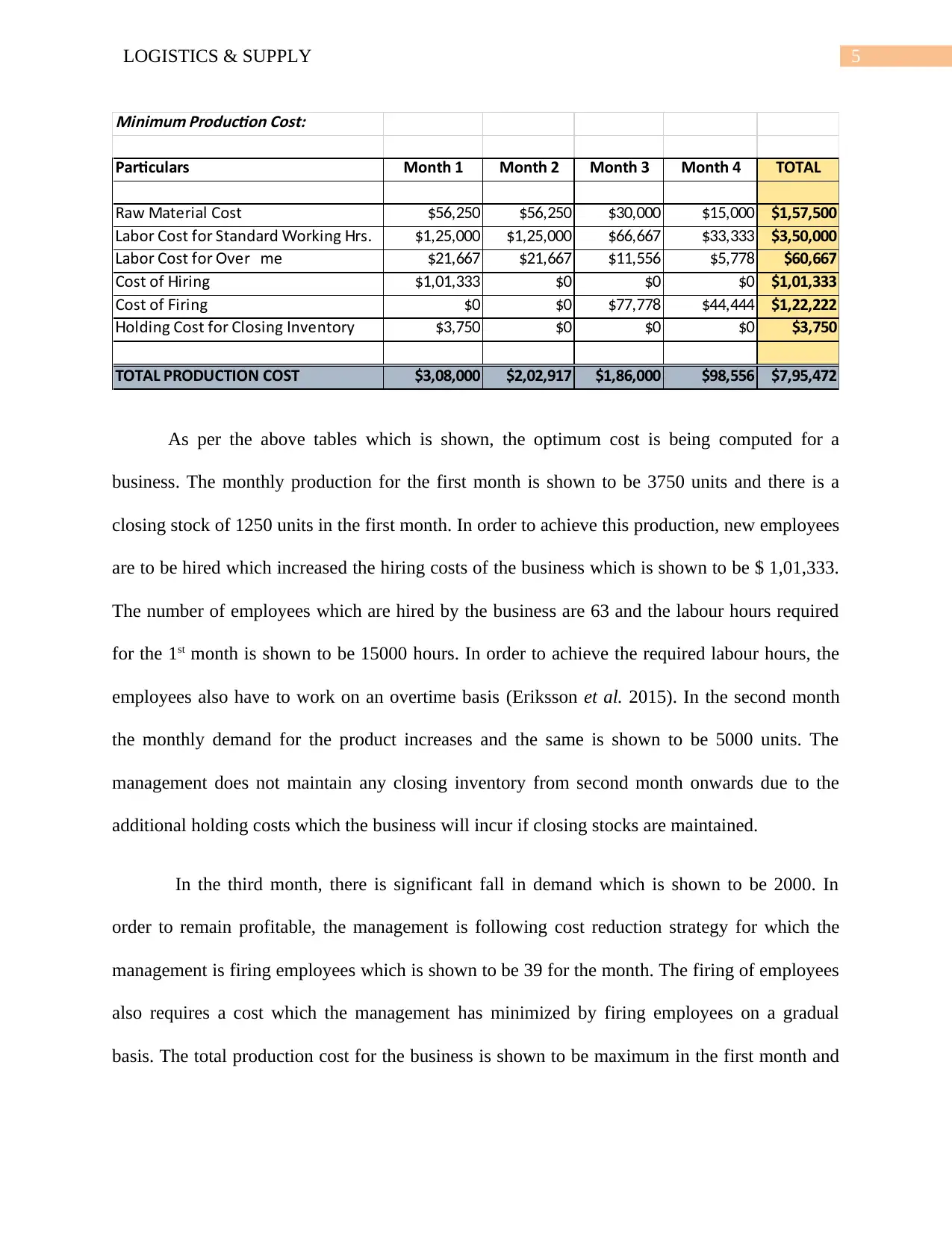
5LOGISTICS & SUPPLY
Minimum Production Cost:
Particulars Month 1 Month 2 Month 3 Month 4 TOTAL
Raw Material Cost $56,250 $56,250 $30,000 $15,000 $1,57,500
abor Cost for Standard orking rsL W H . $1,25,000 $1,25,000 $66,667 $33,333 $3,50,000
abor Cost for verti meL O $21,667 $21,667 $11,556 $5,778 $60,667
Cost of iringH $1,01,333 $0 $0 $0 $1,01,333
Cost of iringF $0 $0 $77,778 $44,444 $1,22,222
olding Cost for Closing nventoryH I $3,750 $0 $0 $0 $3,750
TOTAL PRODUCTION COST $3,08,000 $2,02,917 $1,86,000 $98,556 $7,95,472
As per the above tables which is shown, the optimum cost is being computed for a
business. The monthly production for the first month is shown to be 3750 units and there is a
closing stock of 1250 units in the first month. In order to achieve this production, new employees
are to be hired which increased the hiring costs of the business which is shown to be $ 1,01,333.
The number of employees which are hired by the business are 63 and the labour hours required
for the 1st month is shown to be 15000 hours. In order to achieve the required labour hours, the
employees also have to work on an overtime basis (Eriksson et al. 2015). In the second month
the monthly demand for the product increases and the same is shown to be 5000 units. The
management does not maintain any closing inventory from second month onwards due to the
additional holding costs which the business will incur if closing stocks are maintained.
In the third month, there is significant fall in demand which is shown to be 2000. In
order to remain profitable, the management is following cost reduction strategy for which the
management is firing employees which is shown to be 39 for the month. The firing of employees
also requires a cost which the management has minimized by firing employees on a gradual
basis. The total production cost for the business is shown to be maximum in the first month and
Minimum Production Cost:
Particulars Month 1 Month 2 Month 3 Month 4 TOTAL
Raw Material Cost $56,250 $56,250 $30,000 $15,000 $1,57,500
abor Cost for Standard orking rsL W H . $1,25,000 $1,25,000 $66,667 $33,333 $3,50,000
abor Cost for verti meL O $21,667 $21,667 $11,556 $5,778 $60,667
Cost of iringH $1,01,333 $0 $0 $0 $1,01,333
Cost of iringF $0 $0 $77,778 $44,444 $1,22,222
olding Cost for Closing nventoryH I $3,750 $0 $0 $0 $3,750
TOTAL PRODUCTION COST $3,08,000 $2,02,917 $1,86,000 $98,556 $7,95,472
As per the above tables which is shown, the optimum cost is being computed for a
business. The monthly production for the first month is shown to be 3750 units and there is a
closing stock of 1250 units in the first month. In order to achieve this production, new employees
are to be hired which increased the hiring costs of the business which is shown to be $ 1,01,333.
The number of employees which are hired by the business are 63 and the labour hours required
for the 1st month is shown to be 15000 hours. In order to achieve the required labour hours, the
employees also have to work on an overtime basis (Eriksson et al. 2015). In the second month
the monthly demand for the product increases and the same is shown to be 5000 units. The
management does not maintain any closing inventory from second month onwards due to the
additional holding costs which the business will incur if closing stocks are maintained.
In the third month, there is significant fall in demand which is shown to be 2000. In
order to remain profitable, the management is following cost reduction strategy for which the
management is firing employees which is shown to be 39 for the month. The firing of employees
also requires a cost which the management has minimized by firing employees on a gradual
basis. The total production cost for the business is shown to be maximum in the first month and
⊘ This is a preview!⊘
Do you want full access?
Subscribe today to unlock all pages.

Trusted by 1+ million students worldwide
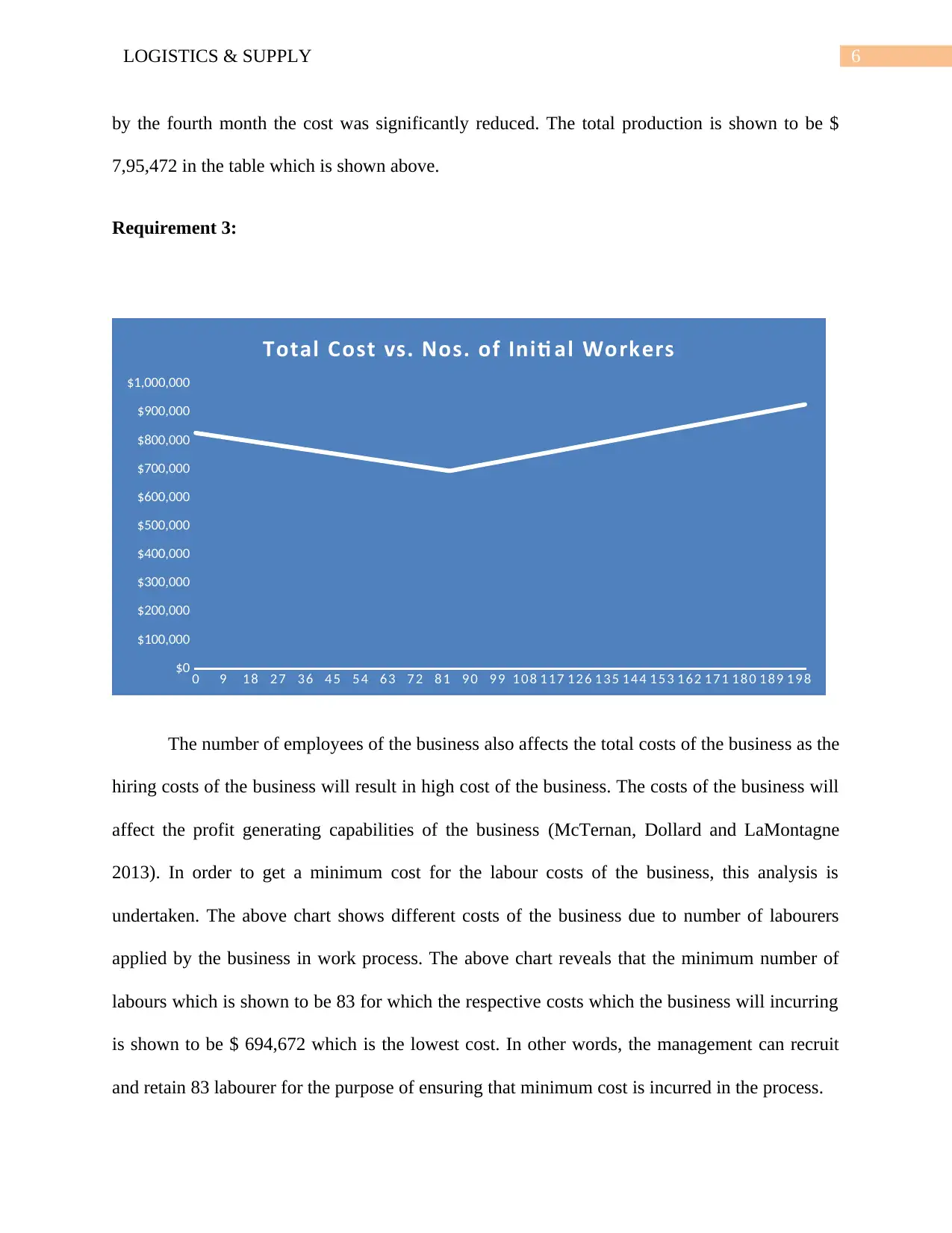
6LOGISTICS & SUPPLY
by the fourth month the cost was significantly reduced. The total production is shown to be $
7,95,472 in the table which is shown above.
Requirement 3:
0 9 1 8 2 7 3 6 4 5 5 4 6 3 7 2 8 1 9 0 9 9 1 0 8 1 1 7 1 2 6 1 3 5 1 4 4 1 5 3 1 6 2 1 7 1 1 8 0 1 8 9 1 9 8
$0
$100,000
$200,000
$300,000
$400,000
$500,000
$600,000
$700,000
$800,000
$900,000
$1,000,000
Total Cost vs. Nos. of Initi al Workers
The number of employees of the business also affects the total costs of the business as the
hiring costs of the business will result in high cost of the business. The costs of the business will
affect the profit generating capabilities of the business (McTernan, Dollard and LaMontagne
2013). In order to get a minimum cost for the labour costs of the business, this analysis is
undertaken. The above chart shows different costs of the business due to number of labourers
applied by the business in work process. The above chart reveals that the minimum number of
labours which is shown to be 83 for which the respective costs which the business will incurring
is shown to be $ 694,672 which is the lowest cost. In other words, the management can recruit
and retain 83 labourer for the purpose of ensuring that minimum cost is incurred in the process.
by the fourth month the cost was significantly reduced. The total production is shown to be $
7,95,472 in the table which is shown above.
Requirement 3:
0 9 1 8 2 7 3 6 4 5 5 4 6 3 7 2 8 1 9 0 9 9 1 0 8 1 1 7 1 2 6 1 3 5 1 4 4 1 5 3 1 6 2 1 7 1 1 8 0 1 8 9 1 9 8
$0
$100,000
$200,000
$300,000
$400,000
$500,000
$600,000
$700,000
$800,000
$900,000
$1,000,000
Total Cost vs. Nos. of Initi al Workers
The number of employees of the business also affects the total costs of the business as the
hiring costs of the business will result in high cost of the business. The costs of the business will
affect the profit generating capabilities of the business (McTernan, Dollard and LaMontagne
2013). In order to get a minimum cost for the labour costs of the business, this analysis is
undertaken. The above chart shows different costs of the business due to number of labourers
applied by the business in work process. The above chart reveals that the minimum number of
labours which is shown to be 83 for which the respective costs which the business will incurring
is shown to be $ 694,672 which is the lowest cost. In other words, the management can recruit
and retain 83 labourer for the purpose of ensuring that minimum cost is incurred in the process.
Paraphrase This Document
Need a fresh take? Get an instant paraphrase of this document with our AI Paraphraser
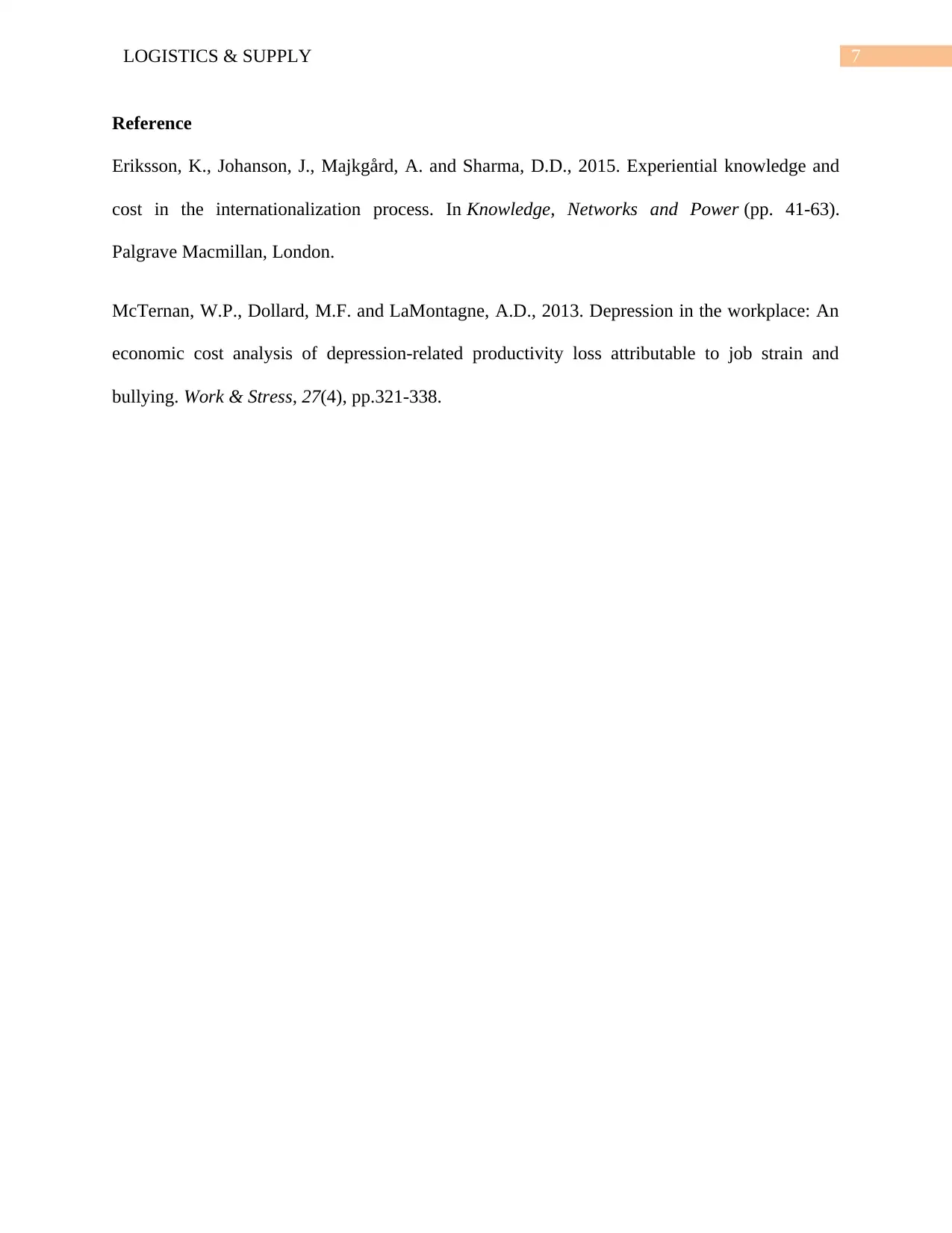
7LOGISTICS & SUPPLY
Reference
Eriksson, K., Johanson, J., Majkgård, A. and Sharma, D.D., 2015. Experiential knowledge and
cost in the internationalization process. In Knowledge, Networks and Power (pp. 41-63).
Palgrave Macmillan, London.
McTernan, W.P., Dollard, M.F. and LaMontagne, A.D., 2013. Depression in the workplace: An
economic cost analysis of depression-related productivity loss attributable to job strain and
bullying. Work & Stress, 27(4), pp.321-338.
Reference
Eriksson, K., Johanson, J., Majkgård, A. and Sharma, D.D., 2015. Experiential knowledge and
cost in the internationalization process. In Knowledge, Networks and Power (pp. 41-63).
Palgrave Macmillan, London.
McTernan, W.P., Dollard, M.F. and LaMontagne, A.D., 2013. Depression in the workplace: An
economic cost analysis of depression-related productivity loss attributable to job strain and
bullying. Work & Stress, 27(4), pp.321-338.
1 out of 8
Your All-in-One AI-Powered Toolkit for Academic Success.
+13062052269
info@desklib.com
Available 24*7 on WhatsApp / Email
![[object Object]](/_next/static/media/star-bottom.7253800d.svg)
Unlock your academic potential
Copyright © 2020–2025 A2Z Services. All Rights Reserved. Developed and managed by ZUCOL.
